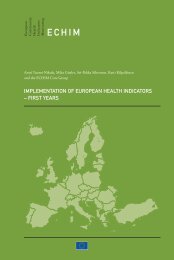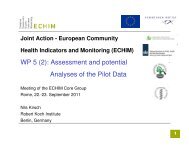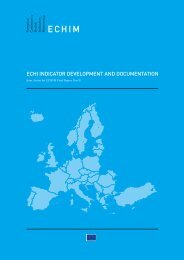INDICATORS
ECHIM Final Report
ECHIM Final Report
Create successful ePaper yourself
Turn your PDF publications into a flip-book with our unique Google optimized e-Paper software.
76. INSURANCE COVERAGE<br />
Definition: The indicator is defined as the proportion of the population covered by<br />
health insurance, taking into account both public and private insurance schemes. Public<br />
(government/social) health insurance refers to tax-based public health insurance including<br />
social security contribution schemes. Private health insurance refers to insurance schemes<br />
financed through private health premiums, i.e., payments that a policyholder agrees to make<br />
for coverage under a given insurance policy, where an insurance policy generally consists of a<br />
contract that is issued by an insurer to a covered person.<br />
Calculation:<br />
1) OECD: proportion (%) of the population covered by a) public and b) private health<br />
insurance.<br />
1a) Public, i.e. government/social health insurance: Share of population (%) eligible for<br />
a defined set of health care goods and services that are included in total public health<br />
expenditure: total health care, in-patient and acute care, out-patient medical care and<br />
pharmaceutical goods. Coverage in this sense is independent of the scope of cost-sharing.<br />
1b) Private health insurance (PrHI): Total PrHI coverage (%) is a head count of all<br />
individuals covered by at least one PrHI policy (including both individuals covered in their<br />
own name and dependents). To avoid duplications, it should not refer to the number of<br />
PrHI policies sold in the country, as individuals may be covered by more than one PrHI<br />
product. Similarly, total population coverage is not necessarily the sum of PrHI coverage by<br />
different types, as an individual may hold more than one PrHI policy.<br />
2) The EU Social Protection Committee Indicator HC-P3 (2008): “The proportion of<br />
the population covered by health insurance”, defined as the percentage of the population<br />
covered by public health insurance (which is defined as tax-based public health insurance and<br />
income-related payroll taxes including social security contribution schemes) + the percentage<br />
of the population covered by private health insurance including: Private mandatory health<br />
insurance, Private employment group health insurance, Private community-rated health<br />
insurance, and Private risk-rated health insurance. Recommended data source is OECD and<br />
national data sources.<br />
Notes:. Preferred data source is OECD (based on national data). It also the recommended<br />
source for the EU Social Protection Committee indicator. For OECD definitions and<br />
explanations concerning public and private health insurance, please see the OECD Health<br />
Data, section “Definitions, Sources and Methods”.<br />
77. EXPENDITURES ON HEALTH<br />
Definition: Total total national health expenditure as percentage of gross domestic product.<br />
Divided into total, public and private sectors. Total national expenditure on health is the<br />
sum of general government health expenditure and private health expenditure in a given year,<br />
calculated in national currency units in current prices. Gross domestic product (GDP) is the<br />
total market value of all final goods and services produced within a country in a given period<br />
of time. This corresponds to the total sum of expenditure (consumption and investment) of<br />
the private and government agents.<br />
Public expenditure on health care: Public funds include state, regional and local Government<br />
bodies and social security schemes. Public capital formation on health includes publicly<br />
financed investment in health facilities plus capital transfers to the private sector for hospital<br />
construction and equipment.<br />
Private expenditure on health care: Private sources of funds include out-of-pocket payments<br />
(both over-the-counter and cost-sharing), private insurance programmes, charities and<br />
occupational health care.<br />
129










